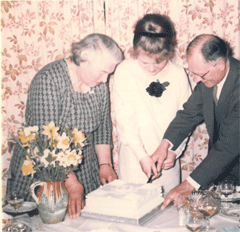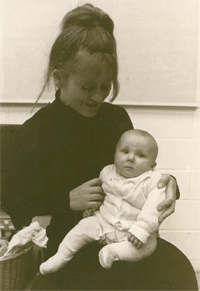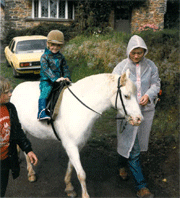In the fourth instalment of our five-part series on Bridget Wilkins and her father Jim Nicholls, Bridget remembers her experiences of having diabetes as a young adult in the Sixties and becoming a mother in the 1980s.series

I (pictured right on my 21st birthday with my father and mother), was put on bovine insulin as the human variety wasn’t on offer in those days. I think it was a mixture of two different insulins – fast and slow acting.
My father taught me how to reduce or increase the amount of carbohydrates I needed for the day, depending on what I was doing, and how my blood glucose levels were behaving. I found this careful balancing between insulin and diet worked well for me. I was able to tell when I was going to go hypo and do something about it before I lost control. The slow-acting insulins also helped with this.
Because I’d been aware of my father giving himself injections, the idea of injecting was not a big thing for me. In those days, we did not use disposable syringes, but glass ones that had to be sterilized and then kept in surgical spirit. At some point we changed to disposable syringes. I still use them and haven’t ever tried a pen device.
Growing up at a time when people didn’t fully understand diabetes, I always thought it was important to explain what diabetes was. I’d take them through the whole process about the body not producing insulin and needing to inject and having to have an exact amount of carbohydrate to balance this.
On the whole this seemed to work, although because diabetes isn’t black and white they didn’t always understand how sometimes I allowed myself a sugary treat and other times I didn’t, depending on what was going on with my blood glucose levels.
I felt it was important to make people aware of diabetes and what it involves to stay alive. I try and explain this today, but I think there are more incorrect preconceived ideas about diabetes now, and confusion between Type 1 and Type 2. Sometimes people think I am a hypocrite – I feel the distinction between the two types should be clearer.

It was not easy, although things were made better by the fact that the finger prick blood sugar monitoring machines had just become available, replacing the test tube urine testing kits which were a nuisance to use.
I was admitted into the Diabetic Maternity Ward at King’s Hospital one month before the due date, just to keep an eye on things during the last few weeks of pregnancy which are the most problematic.
I would wake up and get myself dressed before breakfast and either go for walks or make baby clothes with the sewing machine I’d brought along with me. My daughter Katherine (pictured with me above), came safely into the world in 1980. I am very proud that she was the first baby born in the diabetic mums’ ward at King’s who didn’t have to go into intensive care.
Two years later I was pregnant a second time, although this sadly ended in a termination on medical advice. During this pregnancy I was put on Human insulin. One day I was driving home with Katherine, then aged two, in the back of the car when I felt a hypo coming on.
My mind was so confused because the insulin was acting so quickly, I decided to drive to a sweet shop to get something sweet to eat rather than eat the chocolate bar I actually had on the dashboard.

The emergency services were alerted and we were pulled to safety before disaster struck. Human insulin didn’t suit me and after that pregnancy I went straight back on bovine insulin which I’ve stuck with ever since.
I’m happy to say I’ve never had an incident with hypos like that again. Now my daughter Katherine is 31 years old, married with two children of her own. Abigail is two and James, who was born in February this year, is named after my father Jim."
In the final instalment of our series on Jim Nicholls and his daughter Bridget, you can hear how Bridget manages her diabetes today and how her father’s guidance still influences her.
